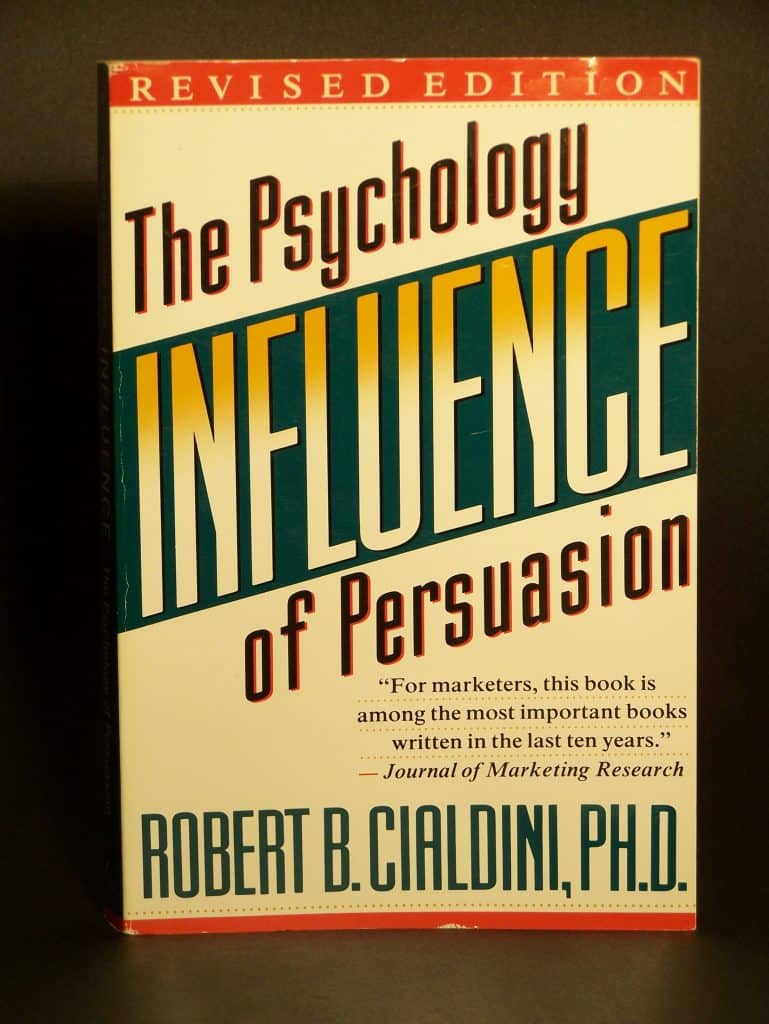
Book Summary – Influence: The Psychology of Persuasion

While we would all like to believe that we are immune to the influence of others, nothing could be further from the truth. The reality is that we are hard-wired to be susceptible to various techniques of influence. Cialdini walks through the most common methods of influence. For each of these he shares examples and explains – based on his research — why they work. The author admits that he is probably one of the folks most prone to influence. His first hand stories, coupled with numerous other examples, provide a wealth of insights in to the topic. Whether you are looking for ways to avoid influence or looking for ways to exert influence, the book is well worth the time to read.
Weapons of Influence – Cialdini starts by making the case that we are pre-disposed to being influenced due to the manner in which we have evolved. He includes a quote by the British philosopher Alfred North Whitehead that speaks to this:
- Civilization advances by extending the number of operations we can perform without thinking of them.
If you accept Whitehead’s premise, it should not come as much of a surprise to find that over time, as society has evolved, we have been conditioned to respond automatically in a great number of situations.
As the book progresses, the author highlights what he refers to as ”weapons of automatic influence”. In this first chapter, he highlights the traits that each of these ”weapons” share. They include:
- Each “weapon” triggers a nearly mechanical process through which we act in an extremely predictable manner to certain stimuli.
- The “weapons” are easily used/deployed by those that know how to create or introduce these trigger events.
- The individuals that use these “weapons” are able to get the desired result with minimal effort / the triggers are quite easy to introduce.
The ability to produce predictable results, in an easy manner, with minimal effort is an incredibly powerful combination. Each of the subsequent chapters reveals “weapons” that share these traits.
He closes the first chapter with a wonderful example:
- A young co-ed has written a letter to her parents describing her newly found delinquent boyfriend, her surprise pregnancy, and a litany of other horrors that would make the vast majority of parents cringe. She then transitions in the letter to reveal that the previously shared information is NOT accurate, and that the real issue is a poor grade she received in one of her courses and appeals to her parents to keep things in perspective.
As you read the story, you can imagine the physical and emotional responses from the parents as the initial situation is laid out and the relief they experience when they find out that things are not nearly as bad as they might seem. The only challenge that the co-ed faces is that she may not have fully anticipated the possible ranges of responses she may get from her parents by perpetrating such a deception! That aside, the example is a wonderful illustration of the predictability of our responses / the ability we have to influence how others react.
Reciprocation
The old adage states that it is better to give than to receive — and Cialdini explains why this is the case! The basic principle in this chapter is that people are hard wired to respond in kind when you give them something, He walks through a number of examples including:
- A tendency to send a Christmas card back to a person that sends us a card.
- Our willingness to give donations when solicitors present us with a flower or a small gift.
- Lyndon Johnson’s ability to get support from his opponents for legislation they did not agree with as a result of the favors he had provided previously to congressmen.
- Your tendency to buy something at the grocery store after you has been given a free sample.
This obligation to repay is extremely powerful. He points out that the reciprocal action does not need to be “equal”; and, in practice, it is actually the case that the reciprocal action is much larger. Many sales and marketers are aware of this and have developed all kinds of techniques to exploit this inequality.
Commitment and Consistency
In this chapter the author discusses our fundamental need to align ourselves with the mental picture we have created of ourselves and to maintain that alignment over time. As a society we value stability – and commitment and consistency are the cornerstones of stability. He points out two key reasons that we behave in this manner:
- Commitment and consistency act as a shortcut for decision making in life. They make life “easy” as we simply need to continue on the path we have chosen.
- Commitment and consistency allow us to avoid the consequences and challenges associate with making the tough choices.
He suggests a number of ways to leverage our need for consistency and commitment, including:
- Writing down what you want to do or achieve. The simple act of “putting it in writing” produces a permanent record and is a form of commitment.
- Providing a public testimonial. When you publicly proclaim something, you have made a commitment AND you want to follow though (i.e. remain consistent) with that commitment.
- Sharing the experience with another. When you partner with another, you have a desire to follow through (consistency and commitment)
- Undertaking large or painful activities. Once you begin the challenging activity you tend to want to follow through to completion (consistency and commitment).
Several additional points regarding commitment and consistency include:
- People are more likely to continue to display an action(s) if their initial demonstration of the action is (i) active, (ii) public, and (iii) requires a higher than normal level of effort.
- The motivation for the action is critical if the action is to be repeated. Providing an external motivation (think giving a child candy for something) will not generally result in long term adoption of the action. Rather, there needs to be some sort of inner motivation for taking the action. These inner motivations cause the person to “see” themselves differently; and, accordingly, their future actions will be consistent with that vision.
Finally, Cialdini offers guidance on how to be aware of when you are falling prey to the consistency/commitment trap. In particular he offers the following two warning signals and how to leverage these to avoid blindly following certain signals:
- When you are approached about certain actions, there is a feeling in the pit of your stomach that tells you something is not right. That is normally a strong indicator that you may be about to fall in to the commitment/consistency trap. At this point in time you need to ask yourself “do I really want to take this action?” If the answer is no, then don’t!
- The second signal is applied AFTER you have made a choice. When you look back on the choice, ask yourself “would I make the same choice again?” However, do NOT pay attention to what you THINK. Pay attention to the immediate feeling that you experience after asking this question. That feeling comes from your “heart of hearts” and provides you with feedback on whether or not the action is likely appropriate. While this approach may not help you to avoid the initial misstep, it is effective in avoiding continued missteps.
Social Proof
Social proof refers to our tendency to act in certain ways simply because others do.
When we face a situation that is unclear or ambiguous, or when we are unsure of what we should be doing, we tend to look to those around us to “tell” us how to act. This simple concept is one of the most powerful methods of influence.
If you accept that we tend to behave in this manner, you can leverage social proof to get others to act in a certain manner simply by acting in that manner yourself. A great example of this is our tendency to blindly laugh when presented with a “laugh track” during a television show. If we perceive that the crowd at the studio set thinks the joke was funny – via the laugh track – we tend to laugh along with them regardless of whether we find the joke funny.
To avoid falling prey to the power of social proof you need recognize when you receive a “false positive” regarding an action you should take. The two most common forms of “false positives” are:
- Purposely falsified social proof. These are those instances where someone is deliberately acting in a manner with the goal of having you follow along. The most common of these is testimonial – we face it in advertising each day! The key to avoiding this form of influence is to ask yourself the direct question, “Am I doing this because it is right for me or because I am blindly following the crowd?”
- Honest errors. These are those times when the entire crowd goes down the wrong path because the first person made a wrong turn. Example of this can be seen every day on the roadways! To avoid this false positive, ask yourself whether you are taking the action because of something you KNOW to be true or simply because the person in front of you is acting in this manner.
Liking
In the sales space, there is a standard recipe of “know, like, trust”. This section of the book focuses on that middle component. Plain and simple, people want to do things for/with those they like. Cialdini presents a number of associated topics related to “liking”:
- Friendship – At the top of our list of those we like are our friends. As a result we are likely to do business with them and/or follow their lead on various topics. The author cites the classic “Tupperware” party where the host brings his/her friends in as an example of how powerful “liking” is in this instance.
- Attractiveness – Study after study has shown that attractive people tend to be more well liked and do better in a variety of situations. The message here is that you need to focus on your appearance – it matters!
- Similarity – People tend to like folks that are similar to themselves in some way. You should work to find commonalities in your interactions with others.
- Compliments – Rare is the person that does not enjoy receiving a compliment! The simple act of providing positive feedback can pay immense dividends.
- Cooperation – Sharing a common cause or purpose brings people together.
- Contact – The more time we spend in close proximity to others, the more we get to know them; and, in turn to like them. This reinforces the importance of getting in front of others as often as possible.
- Association – Have you ever bought a product because your favorite actor, movie star, or sports hero uses the product? Testimonials are used in advertising because they are extremely effective – we want to associate with those we like.
- Dining – The final association they suggest appeals more to the physiological. When we eat, we normally get a positive physical signal. This positive signal is a form of liking and suggests why having a meal with others can be a great way to enhance the relationship.
Liking is 100% normal; and, as such, we should NOT avoid it. However, we should be aware of the difference between liking a person and liking the product/service that they are selling.
Authority
The author starts this section with a story of a classic experiment:
- The subject is brought in to an “experiment” where he/she controls the dial on an electric shock machine. There’s an authority figure (doctor) overseeing the experiment and giving the subject instructions to administer more and more severe shocks to the patient (the patient is an actor and not really receiving any shocks). Despite the pleas of the patient, the subject continues to ramp up the shocks on the direction of the authority figure.
This very sad phenomenon doesn’t just play out in the psychology labs. It’s been repeated in egregious instances throughout history – particularly in war time. And it is probably the best example of the power that authority naturally holds over each of us. We are wired from birth to follow instructions from those in positions of authority. This is what makes authority such a powerful force.
The key to avoiding the influence of authority is to always question whether the person in the position of power really is an authority. The authors encourage us to ask, “How truthful can we expect the expert to be here?”
While this question is theoretically easy to ask, authority is one of the most challenging forms of influence to resist.
Scarcity
Buy now, limited quantities! Have you heard that one before? My guess is yes; and there is a good reason – we are wired to want to avoid “starvation” and when we hear that things are about to become scarce, our brain screams “grab some now”.
There is also a deeper, more subtle psychology associated with scarcity. As items become more scarce, we are deprived of choices. As we relish our independence and freedom, we look for ways to avoid the forthcoming scarcity and acquire the item that is about to become scarce. In essence we have a “double whammy” with our desire to avoid “starvation” and our desire for independence both encouraging us to grab hold of the soon to be scarce item.
For this reason, the technique of first providing the item; and, then subsequently removing the item is one of the most powerful techniques to stimulate demand – think of the drug dealer and his/her free samples.
To avoid the influence of scarcity, it is necessary to understand whether the source of our objection to having the item removed is due to “enjoying its possession” or “enjoying the experience” associated with the item. The author suggests a two-step process. First, as soon as we sense that an item is “scarce” we need to use this sensation to immediately “stop” prior to taking any action. Second, we need to ask whether our desire for the item is based on a want or a need. If it’s a want, we may decide that perhaps it is not as important as we thought and forgo the “last one”. Similarly, if it is a need, we should ask ourselves whether there is any substitute available.
Conclusion
The author has done a beautiful job of highlighting the way we are all programmed to respond to certain stimuli. We can “de-program” ourselves; however, it’s not easy and requires a focused effort. The examples of influence they cite (reciprocation, commitment and consistency, social proof, liking, authority, and scarcity) are extremely powerful, widely encountered, and have proven to be very effective in driving behavior. Their message to avoid being subject to unwanted influence is to step back, assess the “why” behind your action, and only make decisions on the quantifiable facts versus the subjective feelings. While their counsel is extremely wise, it’s often difficult to put in practice due to the power of influence.
If you would like to have a copy of this summary in PDF form to share with others you can click here
If you liked this post, you might want to check out these as well:


